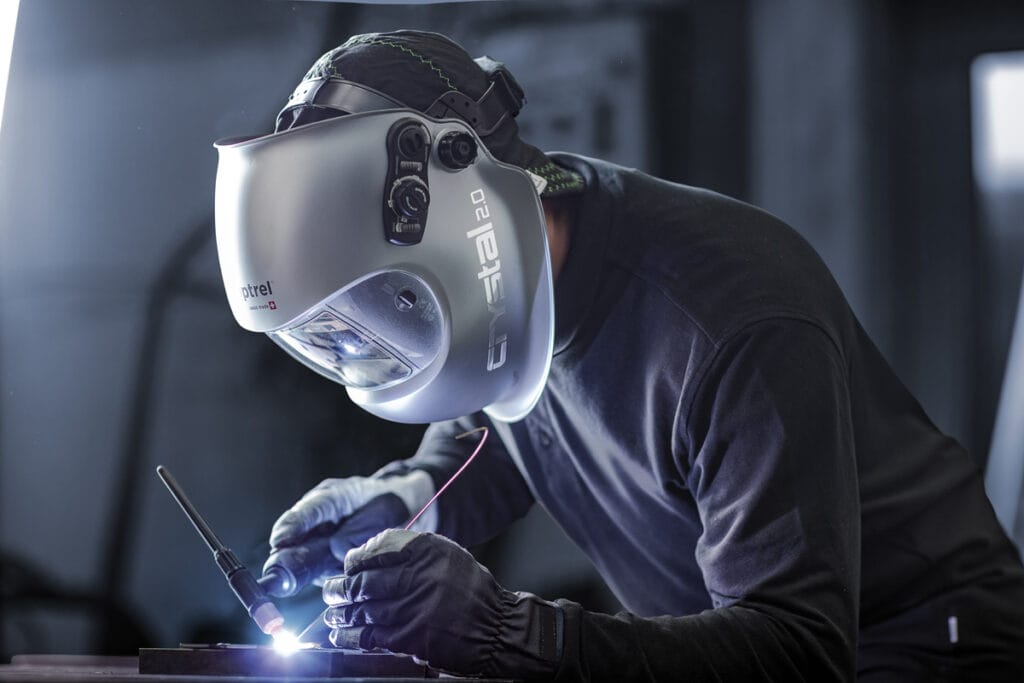
Welding requires precision, skill, and, above all, safety. Protecting your eyes from the intense light, heat, and potential debris generated during welding is non-negotiable. A critical component of this protection is the welding helmet and, more specifically, the quality of its lens. Optical ratings serve as standardized benchmarks, carefully evaluating the performance of these welding filters to guarantee visual clarity and unmatched safety.
Welding filters, like the advanced auto-darkening filters (ADFs), often feature specific markings that provide essential information. While these markings are different from optical ratings, they are crucial for understanding the basic specifications of filters:
While these markings provide a general overview of features and compliance, they do not offer a direct assessment of its optical quality.
That’s where official optical ratings come in.
Welding filters are evaluated according to the EN 379 standard using a four-number format like 1/1/1/1. These ratings measure the lens’s optical quality. They are important for picking a filter that offers both clear vision and good protection. Each number ranges from 1 (best) to 3 (lowest), representing performance in four categories:
This rating assesses the clarity of the image and the level of distortion caused by the lens. A class 1 rating ensures minimal distortion, allowing the welder to see fine details clearly. Lower classes (2 or 3) may cause blurring or bending of straight lines, making it harder to work precisely.
This measures the lens’s ability to block stray light that scatters within the filter. Blocking stray light improves contrast and sharpness. A class 1 rating minimizes this effect, giving a clearer, more focused view and helping to prevent eye strain during long shifts.
This checks how consistent the shade is across the whole surface of the filter when viewed at a 90° angle. Consistent shading is essential to prevent distractions and visual discomfort. A class 1 rating ensures a uniform shade from corner to corner, maintaining consistent protection and reducing eye strain.
This measures how the filter’s performance changes when viewed from different angles. Welders often avoid looking directly at the arc. This is especially true for overhead or out-of-position welds. Class 1 lenses maintain consistent shade at all angles, while lower ratings may affect visibility because of varying darkness.
According to current safety standards, a welding filter that achieves a 1/1/1/1 rating across all four categories represents the pinnacle of optical performance. This gives welders the best combination of clarity, uniformity of shade, and performance, contributing to safer and higher-quality experience.
All four components of the optical rating are important. Arguably, angular dependence is the most important, even more true for welders working in difficult positions.
Angular dependence addresses the filter’s shade level and the consistency of its color as the welder’s viewing angle shifts.
This is similar to looking through partially open window blinds, where the view and light intensity change with the angle. Lower-rated filters can produce this effect, potentially causing discomfort or uneven protection.
Welders often work in confined spaces or awkward positions that misalign their eyes with the arc. In these situations, a high angular dependence rating is important. It helps prevent eye strain and visual distortion. This rating also ensures comfort and weld quality in changing work conditions.
Recognizing the needs of welding professionals, Optrel has engineered welding helmets with Class 1 and Class 2 angular dependency ratings. This empowers welders to select the lens that aligns with their environments, to maximize optical clarity and consistency.
Optrel offers the e684, Panoramaxx Quattro, and Helix Quattro. These lenses provide steady shading for environments that need it. This includes overhead welding, pipefitting, and working in tight spaces. They ensure a stable and uniform darkening effect regardless of the viewing angle.
Optrel provides the Crystal 2.0, Panoramaxx CLT, and Helix CLT. These lenses offer a remarkably clear view of the arc, although they may show slight color changes at extreme angles.
Optrel’s 2.5 Lens is available in the Sphere, Panoramaxx, and Helix series. This lens offers a balanced effect. With a Class 2 angular dependency, this lens stands out for its bright light state (shade level 2.5) and true-color technology. A great choice for welders who want good visibility and steady angles for general welding tasks.
Ultimately, choosing the best helmet lens hinges depends on careful evaluation:
To further assist your decision making, explore our this guide for a comparison of our welding helmets.